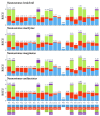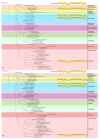Complete Mitochondrial Genomes of Nannostomus Pencilfish: Genome Characterization and Phylogenetic Analysis
- PMID: 38891645
- PMCID: PMC11171051
- DOI: 10.3390/ani14111598
Complete Mitochondrial Genomes of Nannostomus Pencilfish: Genome Characterization and Phylogenetic Analysis
Abstract
Although the pencilfish is a globally popular economic fish in the aquarium market, its taxonomic classification could be further refined. In order to understand the taxonomy of species of the genus Nannostomus (Characiformes, Lebiasinidae) and their phylogenetic position within the order Characiformes, in this study, we characterized mitochondrial genomes (mitogenomes) from four Nannostomus species for the first time. The four mitogenomes exhibited the typical circular structure, with overall sizes varying from 16,661 bp to 16,690 bp. They contained 13 protein-coding genes (PCGs), 2 ribosomal RNA genes (rRNAs), 22 transfer RNA genes (tRNAs), and 1 control region (CR). Nucleotide composition analysis suggested that the mitochondrial sequences were biased toward A and T. Bayesian inference and maximum likelihood analyses based on PCGs support the family Lebiasinidae classification, described using four Nannostomus species, clustering together with Lebiasina multimaculata from the same family. The results of this study support the current taxonomic classification of the family Lebiasinidae. Phylogenetic analysis also suggested that gene rearrangement would not significantly impact the phylogenetic relationships within the order Characiformes. These results might provide new data regarding the phylogeny and classification of the order Characiformes, thus providing a theoretical basis for the economic development of aquarium fish markets.
Keywords: Nannostomus; aquarium fish; mitochondrial genomes; pencilfish; phylogenetic analysis.
Conflict of interest statement
The authors declare no conflicts of interest.
Figures








Similar articles
-
Complete mitochondrial genome sequence of Nannostomus eques and comparative analysis with Nannostomus beckfordi.Mol Genet Genomics. 2024 Dec 20;300(1):3. doi: 10.1007/s00438-024-02212-8. Mol Genet Genomics. 2024. PMID: 39704846
-
Sequence comparison of the mitochondrial genomes of Plesionika species (Caridea: Pandalidae), gene rearrangement and phylogenetic relationships of Caridea.PeerJ. 2024 May 22;12:e17314. doi: 10.7717/peerj.17314. eCollection 2024. PeerJ. 2024. PMID: 38799064 Free PMC article.
-
Molecular signature of the D-loop in the brown pencilfish Nannostomus eques (Characiformes, Lebiasinidae) reveals at least two evolutionary units in the Rio Negro basin, Brazil.J Fish Biol. 2012 Jul;81(1):110-24. doi: 10.1111/j.1095-8649.2012.03320.x. Epub 2012 May 22. J Fish Biol. 2012. PMID: 22747807
-
Characterization of two new Pylorgus mitogenomes (Hemiptera, Lygaeidae, Ischnorhynchinae) and a mitochondrial phylogeny of Lygaeoidea.Zookeys. 2023 Jun 8;1166:141-154. doi: 10.3897/zookeys.1166.104103. eCollection 2023. Zookeys. 2023. PMID: 37333899 Free PMC article.
-
Complete mitochondrial genomes of Thyreophagus entomophagus and Acarus siro (Sarcoptiformes: Astigmatina) provide insight into mitogenome features, evolution, and phylogeny among Acaroidea mites.Exp Appl Acarol. 2022 Sep;88(1):57-74. doi: 10.1007/s10493-022-00745-4. Epub 2022 Oct 18. Exp Appl Acarol. 2022. PMID: 36255591 Review.
Cited by
-
Structural characteristics of mitochondrial genome of Spirobo-lus walkeri (Spirobolida: Spirobolidae), and phylogenetic analysis of Diplopoda.Front Genet. 2025 Mar 17;16:1566634. doi: 10.3389/fgene.2025.1566634. eCollection 2025. Front Genet. 2025. PMID: 40165936 Free PMC article.
-
Complete mitochondrial genome sequence of Nannostomus eques and comparative analysis with Nannostomus beckfordi.Mol Genet Genomics. 2024 Dec 20;300(1):3. doi: 10.1007/s00438-024-02212-8. Mol Genet Genomics. 2024. PMID: 39704846
References
-
- Sember A., de Oliveira E.A., Ráb P., Bertollo L.A.C., de Freitas N.L., Viana P.F., Yano C.F., Hatanaka T., Marinho M.M.F., de Moraes R.L.R., et al. Centric Fusions behind the Karyotype Evolution of Neotropical Nannostomus Pencilfishes (Characiforme, Lebiasinidae): First Insights from a Molecular Cytogenetic Perspective. Genes. 2020;11:91. doi: 10.3390/genes11010091. - DOI - PMC - PubMed
-
- Beheregaray L.B., Schwartz T.S., Möller L.M., Call D., Chao N.L., Caccone A. A set of microsatellite DNA markers for the one-lined pencilfish Nannostomus unifasciatus, an Amazonian flooded forest fish. Mol. Ecol. Notes. 2004;4:333–335. doi: 10.1111/j.1471-8286.2004.00687.x. - DOI
-
- Terencio M.L., Schneider C.H., Porto J.I.R. Molecular signature of the D-loop in the brown pencilfish Nannostomus eques (Characiformes, Lebiasinidae) reveals at least two evolutionary units in the Rio Negro basin, Brazil. J. Fish Biol. 2012;81:110–124. doi: 10.1111/j.1095-8649.2012.03320.x. - DOI - PubMed
-
- Magalhães A.L.B., Daga V.S., Bezerra L.A.V., Vitule J.R.S., Jacobi C.M., Silva L.G.M. All the colors of the world: Biotic homogenization-differentiation dynamics of freshwater fish communities on demand of the Brazilian aquarium trade. Hydrobiologia. 2020;847:3897–3915. doi: 10.1007/s10750-020-04307-w. - DOI
Grants and funding
LinkOut - more resources
Full Text Sources

